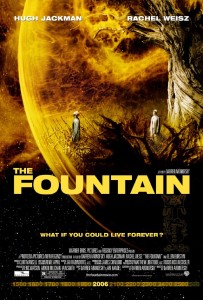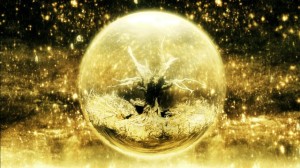Cinema Revisited: Exploring Mortality in The Fountain

The theatrical poster for “The Fountain.”
Themes of life, death, disease, and immortality are all woven together in Darren Aronofsky’s The Fountain, a very ambitious film that delivers three separate story lines spanning a thousand years. One takes place 500 years ago, and follows Spanish Conquistador Tomas and his search for the tree of life. The next takes place in present day as we watch Doctor Tommy Creo (Hugh Jackman) look for a cure to treat his dying wife Izzi’s (Rachel Weisz) disease. The third segment occurs 500 years in the future as Tom travels though outer space in what seems to be a bubble, and makes his way toward the Shebulba nebula.
Starting 500 years in the past, we learn that the Queen (Weisz) is under attack from the Grand Inquisitor for trying to find the tree of life in pursuit of immortality. They believe this to be an act of religious heresy and are capturing and killing anyone found to be in correlation with the Queen’s orders.
The present day segment is the largest and most well developed of the film’s segments. Dr. Creo works fervently trying to discover a cure for his wife’s disease. He is driven to find a solution to her sickness, and believes that death is just a disease, and can be cured like anything else. One night he finds Izzi out on the roof looking through her telescope at Shebulba, and she shows him the book she’s been writing, “The Fountain.” It’s a story about man’s pursuit of immortality so he can be with the one he loves forever.
Jackman is incredibly strong in the main role; he carries the majority of the film’s dramatic weight on his shoulders, and does so in a believable way. He is required to show a range of emotions, most of which are sadness and despair, and he does this effectively. The film handles these heavy emotions well and doesn’t become overly sappy or sentimental.
Another strong aspect of The Fountain is the visual effects, especially during the futuristic, space traveling sequence. Aronofsky video captured chemical reactions in Petri dishes and used them as the visuals for this portion of the movie and those effects work well and give the film a unique and beautiful look.
In the future segment, which serves as the film’s most challenging and interpretive section, Tom travels to the Shebulba nebula in a space orb accompanied by the tree of life, which is dying. Along the way, he experiences what seem to be flash backs or hallucinations of the past, and his wife. It is a race against time, as he tries to reach Shebulba before the tree dies.

A still from “The Fountain.” © 2006 Warner Bros. Entertainment Inc. and Regency Entertainment (USA) Inc. – United States 2006 Warner Bros. Entertainment Inc.
Over the course of the film, we learn that Shebulba is a dying nebula and plays an important part in the Mayan culture; it serves as their underworld and the place where dead souls go to be reborn. This theme of death and rebirth plays heavily throughout the film, with Jackman’s character representing man’s eternal quest for immortality. All three story lines interconnect and serve the idea of death as an act of creation.
One of the great things about The Fountain is its ambiguities. This is a film for those who like to think, and enjoy a film about ideas. The last fifteen minutes are amongst its most ambiguous, and how effective and meaningful they are will rely on the viewer’s own interpretation. It reminded me somewhat of Stanley Kubrick’s 2001: A Space Odyssey as there are no clear cut answers and it is a portion of the film that’s meant to be experienced rather than understood.
The Fountain is certainly not everyone’s cup of tea, especially those who like obvious answers and happy endings (apologies if that suggests a spoiler to you). It’s a challenging movie, but I believe it can also serve as a rewarding one if you give it time to soak in, and you take the time to explore and think about its questions and ideas.


